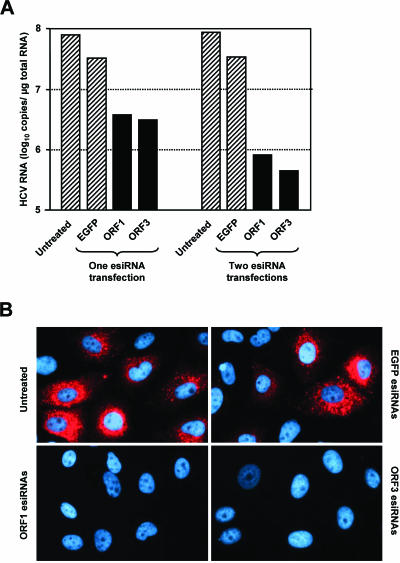FIG. 4.
Effect of esiRNAs on the replication of a full-length HCV replicon. (A) Effect of esiRNAs on HCV RNA copy number. About 2 × 105 cells of the Huh-7 clone 20-1 (containing the replicon I389/Core-3′/5.1) were transfected with 1 μg of genotype 1b-specific esiRNAs (ORF1, ORF3, or EGFP) or were left untreated. Half of the cells were harvested 2 days later. The other half was passaged (split ratio, 1:4), seeded into new cell culture dishes, and transfected a second time or left untreated. Two days later, these cells were also harvested, RNAs were prepared, and the replicon copy numbers per microgram of total RNA were determined by quantitative RT-PCR. Hatched columns, viral RNA concentration in control cells; black columns, viral RNA concentration after the transfection of HCV-specific esiRNAs. The figure shows the results from a single representative experiment. (B) Effect of esiRNAs on the expression of NS5A. About 2 × 105 cells of clone 20-1 were transfected with 1.5 μg of esiRNAs (ORF1, ORF3, or EGFP) or were left untreated. Two days later, the cells were split in a ratio of 1:3 and seeded onto glass coverslips. After 2 days of further cultivation, cells were fixed, permeabilized, and immunostained for NS5A (red) and counterstained for DNA (blue) by using an NS5A-specific mouse monoclonal antibody and DAPI, respectively.

